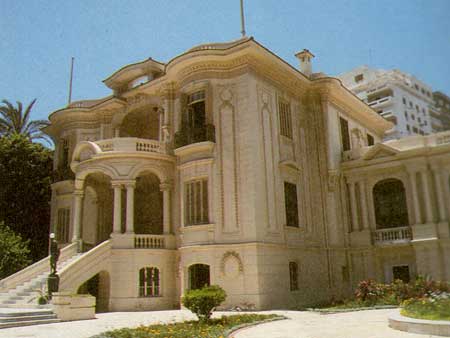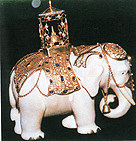Alexandria contains many important museums. It was the capital of Egypt and the place where the ruling took place. Even during its darkest times, Alexandria remained a beacon for knowledge, culture, and thought. It is also a witness on the history of Egypt as it contains Greek, Roman and Islamic monuments.
Alexandria has many of the most important museums in Egypt such as the Graeco-Roman Museum, the Alexandria National Museum and the Royal Jewelry Museum (the Jewelry Museum) or as it is sometimes called the Jewelry Palace because it is located in the palace that used to belong to one of the princesses of the Mohamed Ali dynasty. This museum is located in the Zizinia/ Gleem neighborhood next to the headquarters of the governorate of Alexandria.
The museum lies between Ahmed Yehia Street on its southern side, Abdel Salam Aref Street on its northern side, Ahmed Osma Street on its eastern side and the headquarters of the governorate on its western side.
The History of the Museum (Palace)
This museum was once the palace of Fatma Al Zahara. It was founded by Zeinab Hanem Fahmy in 1919 and was completed by her daughter Princess Fatma Al Zahraa in 1923 where she lived after its completion.
Fatma Al Zahraa whose name the palace carries is one of the princesses of the Mohamed Ali dynasty. She was born in 1903 and her mother is Zeinab Fahmy, sister of architect Ali Fahmy who took part in designing the palace. Her father is Prince Ali Heidar son of Prince Ahmed Rushdi son of Prince Mustafa Bahgat son of Fadel Pasha son of Ibrahim Pasha who is son of Mohamed Ali Pasha ruler of Egypt and founder of modern Egypt. In short, Mohamed Ali is Fatma’s great great great great great grandfather.
When Zeinab Fahmy, Fatma Al Zahraa’s mother, was still alive, the western suite of the palace was completed before she died when her daughter was already 8 years old. Princess Fatma Al Zahraa added an eastern suite in the palace and connected the two suites by a corridor.
This palace was used as a summer residence till the 1952 Revolution. When the Princess’s property was confiscated, she was allowed to stay in the palace till 1964 then Princess
Fatma ceded the palace to the Egyptian government and she left to Cairo where she died in 1983.
This palace was then used as a presidential residence in Alexandria till it was converted into a museum in 1986.
The museum was inaugurated on October 24, 1986
It’s a masterpiece of fine architecture and art. Built in 1919 along European lines, its surface area is 4,185-m² and it is surrounded by gardens. It consists of two suites, a western and an eastern suite connected by a corridor. Each suite consists of two floors and a basement. Moreover, its halls contain many rare paintings, statues and decorations. The palace rooms and lobbies are rich in fine art paintings.
The walls and ceilings are also adorned with oil paintings depicting various historical scenes and natural scenery. The palace windows are decorated with lead-inlaid glass artwork also depicting European-style historical scenes.
This museum was restored and rennovated in 1986 and in 1994. Since late 2004, the Supreme Council of Antiquities started a huge project of rennovating the museum at a total price of 10 million Egyptian pounds so that the museum might accomodate more precious antiquities that are kept in the stores and have not been displayed yet.
Jewelry Collections in the Museum
This Museum includes amazing quantity of the precious and rare jewelry related to the Mohamed Ali’s Family that was worn by King Fouad and King Farouk and their wives and the princes and princesses in the royal family. That is why the museum is called The Royal Jewlery Museum.
The Museum includes 11,500 pieces of jewelry related to the Mohamed Ali dynasty. The palace is divided into ten halls, each consists of a collection of antiquities and jewelry, most important of which: a collection related to the founder of the dynasty, Mohamed Ali himself. Another collection is related to Prince Mohamed Ali Tawfik that includes 12 cups made of platinium and gold and about 2753 pieces of diamond, a wallet adorned with gold and diamonds and a pocket watch related to Ottoman Sultans. There is also another collection related to the Khedive Said Pasha that includes a number of scarves, golden watches, medals, Egyptian, Turkish and foreign necklaces adorned with various precious stones and gold and about 4,000 rare coins.
A collection related to King Fouad that includes:
-Golden medals and decorations with his picture printed on them
- A crown made of platinium and adorned with dinamonds that belonged to his wife Princess Shwikar
- A jewelry collection of Queen Nazli
A collection related to King Farouk and Queen Nazli that includes:
- Chess adorned with gold and diamonds
- A golden tray that has the signatures of 100 pashas
- A plate adorned with rubies that was a gift from the Caesar of Russia
A collection related to Queen Nariman that includes:
- Decorations, orders and medals
A Collection related to Princesses Fawzeya Ahmed Fouad and Fa’eza Ahmed Fouad that includes:
- A collection of bracelets, pins and hairbands
- A hairband made of platinium and adorned with diamonds that has the name “Fawzeya” on it
- A golden necklace adorned with diamonds and pearls with the name “Fa’eza” on it
A collection related to Princesses Samiha Hussein Kamel and Kadreya Hussein Kamel that includes a collection of pocket watches made of gold and adorned with diamonds and a golden bracelet that has diamonds and pearls.
There is also a collection related to Princes Youssef Kamal and Mohamed Ali Tawfik that includes jewelry, medals, orders and decorations in addition to other collections that were exhibited using lightening which is distributed in a special way to display these collections in an interesting way. The cases where the collections are kept have been supplied by cards in Arabic and English to explain what each piece is as well as its history.
Finally, this museum is one of the main attractions in Alexandria and it opens its doors to both Egyptians and tourists. The entry tickets for Egyptians cost little to encourage them to visit this important museum and enjoy seeing the collections of antiquities and jewelry that are so precious, rare and unrivaled in their beauty in the whole world.


I. Background & Significance
- Role: Represents Egypt’s & Alexandria’s history, showcasing Greek, Roman, and Islamic influences.
- Importance: One of Egypt’s key museums (alongside Graeco-Roman & Alexandria National Museums).
- Nickname: “Jewelry Palace” (housed in a former royal palace).
II. Location
- Neighborhood: Zizinia/Gleem.
- Adjacent to: Alexandria Governorate Headquarters.
- Boundaries:
- South: Ahmed Yehia Street
- North: Abdel Salam Aref Street
- East: Ahmed Osma Street
- West: Governorate HQ
III. History & Architecture
- Original Owners:
- Founded by Zeinab Hanem Fahmy (1919).
- Completed & lived in by her daughter, Princess Fatma Al Zahraa (1923).
- Fatma was a descendant of Mohamed Ali Pasha (great x5 granddaughter).
- Palace Structure:
- Built in European style (1919), surface area: 4,185 m² + gardens.
- Two suites (Western – completed first, Eastern – added by Fatma) connected by a corridor.
- Each suite: 2 floors + basement.
- Artistic Features:
- Rare paintings, statues, decorations.
- Walls/ceilings: Oil paintings (historical scenes, nature).
- Windows: Lead-inlaid glass artwork (European historical scenes).
- Timeline:
- Summer residence until the 1952 Revolution.
- Confiscated, but Fatma stayed until 1964 (ceded to government, died 1983).
- Used as presidential residence.
- Converted to a museum (1986), inaugurated Oct 24, 1986.
- Renovations:
- 1986, 1994.
- Major renovation started late 2004 (cost: 10 million EGP, aimed to display stored artifacts).
- Ongoing as of Feb 2007 (expected completion: Summer 2007).
IV. The Jewelry Collection
- Focus: Precious jewelry of the Mohamed Ali Dynasty (worn by kings, queens, princes, princesses).
- Scale: Approx. 11,500 pieces.
- Display: 10 themed halls, special lighting, explanatory cards (Arabic/English).
Key Collections:
- Mohamed Ali Pasha: Founder’s collection.
- Prince Mohamed Ali Tawfik:
- 12 platinum/gold cups (~2,753 diamonds).
- Gold/diamond wallet.
- Ottoman Sultan’s pocket watch.
- Khedive Said Pasha:
- Scarves, golden watches, medals.
- Egyptian/Turkish/foreign necklaces (precious stones, gold).
- ~4,000 rare coins.
- King Fouad:
- Golden medals/decorations (his image).
- Platinum/diamond crown (Princess Shwikar).
- Queen Nazli’s jewelry.
- King Farouk & Queen Nazli:
- Gold/diamond chess set.
- Golden tray (signatures of 100 pashas).
- Ruby-adorned plate (gift from Russian Caesar).
- Queen Nariman: Decorations, orders, medals.
- Princesses Fawzeya & Fa’eza Ahmed Fouad:
- Bracelets, pins, hairbands.
- Platinum/diamond hairband (“Fawzeya”).
- Gold/diamond/pearl necklace (“Fa’eza”).
- Princesses Samiha & Kadreya Hussein Kamel:
- Gold/diamond pocket watches.
- Gold/diamond/pearl bracelet.
- Princes Youssef Kamal & Mohamed Ali Tawfik: Jewelry, medals, orders, decorations.
V. Visitor Information
- Status: Major Alexandria attraction.
- Accessibility: Open to Egyptians and tourists.
- Ticket Policy: Low cost for Egyptians to encourage visitation.
- Value: Showcases globally unique, precious, and rare jewelry collections.
This museum stands as a unique testament to Egypt’s royal heritage through its stunning architecture and unparalleled jewelry collection.
